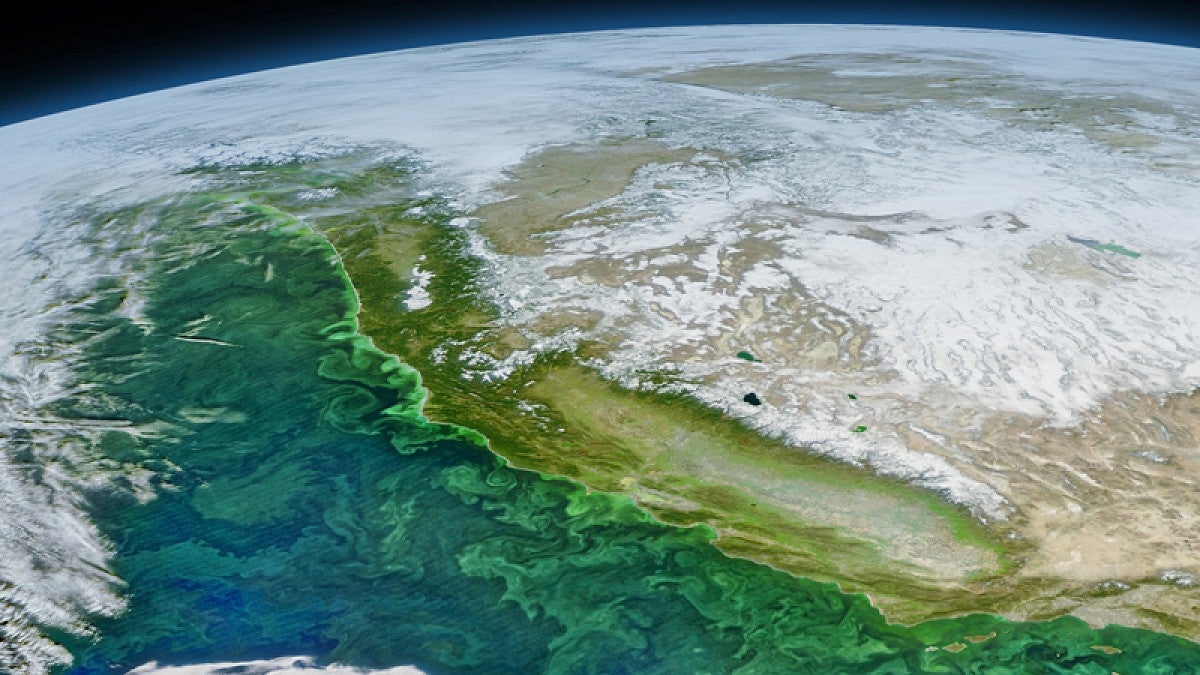Algae-produced domoic acid — a brain-impacting toxin first identified 30 years ago — in the ocean off the Pacific Northwest is a health risk for humans, birds, sea lions and wildlife that eat contaminated shellfish.
Early warning of its presence, which has led to repeated shutdowns of crab and shellfish harvesting, now may be possible because of new findings that emerged from a collaboration involving the UO and Oregon State University.
"Domoic Acid was an unknown algal toxin until it killed people who ate mussels harvested at Prince Edward Island in 1987," said Michelle Wood, a professor of biology and scientist in the UO's Institute of Ecology and Evolution. "After that, this toxin was confirmed to be present on California coast in 1991. Some scientists now think that the crazy birds that inspired Alfred Hitchcock’s thriller 'The Birds' were actually experiencing domoic acid poisoning."
In paper published online Jan. 9 by the Proceedings of the National Academy of Sciences, Wood and colleagues report the development of a predictive model based on their discovery of a strong correlation linking toxic levels of domoic acid in shellfish with El Nino events and warm phases of ocean patterns in the Pacific Ocean.
“Since the 1991 event," Wood said, "we have seen more and more accumulations of domoic acid in shellfish, but it has been difficult to link the occurrence of algae blooms of phytoplankton that produce the toxins to specific environmental parameters."
Exposure to domoic acid causes lethargy, disorientation and seizures in marine mammals and birds. In humans, it can cause memory loss or amnesic shellfish poisoning. In rare cases, exposure can be fatal.
In making their discovery, OSU doctoral student Morgaine McKibben used a combination of time-series data spanning two decades to help the research team establish a link to the climate conditions.
The predictive model that followed is based on interpreting the status of the Oceanic Nino Index and the Pacific Decadal Oscillation, both of which are measures of climate, ocean water movement, currents and temperature. The model can help coastal resource managers more effectively monitor this issue and protect public health.
Wood became involved in Oregon's efforts to monitor harmful algae blooms soon after joining the UO in 1990. "At that time," she said, "there were few phytoplankton ecologists working in Oregon, and the timing coincided with the first reports of domoic acid causing problems on the West Coast."
In 1993 Wood published a paper with graduate student Nicole Apelian and Lynda Shapiro, then director of the UO's Oregon Institute of Marine Biology, that speculated that the harmful algal species might be a component of global climate change.
In a collaboration that Wood began in 2004 with OSU oceanographer Pete Strutton, researchers have used satellite oceanography and field studies to follow patterns of the bloom species in time and location. The work was expanded through a larger partnership, Monitoring Oregon Harmful Algae, which also involved scientists from the National Oceanic and Atmospheric Administration and the Oregon Department of Fish and Wildlife.
McKibben was the first to pull the data together in a way allows for prediction of risk and shows a clear link to climate, Wood said.
“In the natural world there are always variations, and it’s been difficult to connect a specific event to larger forces that operate over periods of years and decades,” said team member and co-author Angelicque White of OSU's College of Earth, Oceanic and Atmospheric Sciences.
The new study shows that oscillations to positive, or warm-favorable, conditions in natural climate cycles can reduce the strength of the south-flowing California Current. This allows northward movement of warmer waters and higher levels of toxic plankton and also brings that toxic mix closer to shore where it can infiltrate shellfish.
"While the database Morgaine developed to help test the model had its roots in work started at the UO in the 1990s, our contribution to this paper was primarily advice on different approaches, and assistance with interpretation and writing," Wood said.
Closures of Pacific Northwest beaches, especially those in 2003, 2015 and 2016 can result in large economic impacts to coastal towns and tourism. In 2015 alone, the closure led to a decline in value of nearly $100 million for the West Coast Dungeness crab fishery, according to the Fisheries of the U.S. Report 2015.
Harmful algal blooms used to be referred to as red tides, Wood said, but that association is no longer used since many harmful algae — like the one that produces domoic acid — do not discolor the water in any way that a person would definitively notice while strolling the beaches.
“The golden-brown foam you sometimes see at the beach can be a sign of algal growth, but not necessarily from a harmful species,” Wood said. “We are continuing to better understand what produces foam and why some of it is harmful. What people need to look for are signs that Oregon Department of Agriculture posts on the beach when shellfish beds are closed to harvest. They will always say 'domoic acid' if that is the source of the problem and should always be respected."
—By Jim Barlow, University Communications, and David Stauth, OSU News and Research Communications


